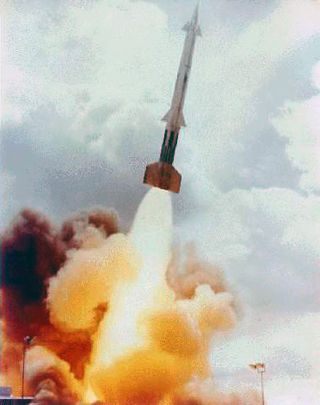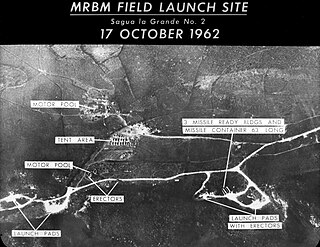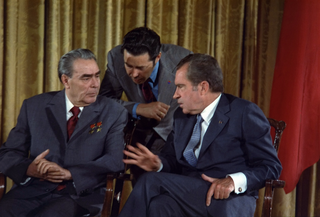
The Anti-Ballistic Missile Treaty, also known as the ABM Treaty or ABMT, was an arms control treaty between the United States and the Soviet Union on the limitation of the anti-ballistic missile (ABM) systems used in defending areas against ballistic missile-delivered nuclear weapons. It was intended to reduce pressures to build more nuclear weapons to maintain deterrence. Under the terms of the treaty, each party was limited to two ABM complexes, each of which was to be limited to 100 anti-ballistic missiles.

Nuclear disarmament is the act of reducing or eliminating nuclear weapons. Its end state can also be a nuclear-weapons-free world, in which nuclear weapons are completely eliminated. The term denuclearization is also used to describe the process leading to complete nuclear disarmament.
Mutual assured destruction (MAD) is a doctrine of military strategy and national security policy which posits that a full-scale use of nuclear weapons by an attacker on a nuclear-armed defender with second-strike capabilities would result in the complete annihilation of both the attacker and the defender. It is based on the theory of rational deterrence, which holds that the threat of using strong weapons against the enemy prevents the enemy's use of those same weapons. The strategy is a form of Nash equilibrium in which, once armed, neither side has any incentive to initiate a conflict or to disarm.

In nuclear ethics and deterrence theory, no first use (NFU) refers to a type of pledge or policy wherein a nuclear power formally refrains from the use of nuclear weapons or other weapons of mass destruction (WMD) in warfare, except for as a second strike in retaliation to an attack by an enemy power using WMD. Such a pledge would allow for a unique state of affairs in which a given nuclear power can be engaged in a conflict of conventional weaponry while it formally forswears any of the strategic advantages of nuclear weapons, provided the enemy power does not possess or utilize any such weapons of their own. The concept is primarily invoked in reference to nuclear mutually assured destruction but has also been applied to chemical and biological warfare, as is the case of the official WMD policy of India.

Richard Norman Perle is an American political advisor who served as the Assistant Secretary of Defense for Global Strategic Affairs under President Ronald Reagan. He began his political career as a senior staff member to Senator Henry "Scoop" Jackson on the Senate Armed Services Committee in the 1970s. He served on the Defense Policy Board Advisory Committee from 1987 to 2004 where he served as chairman from 2001 to 2003 under the Bush administration before resigning due to conflict of interests.

Brinkmanship or brinksmanship is the practice of trying to achieve an advantageous outcome by pushing dangerous events to the brink of active conflict. The maneuver of pushing a situation with the opponent to the brink succeeds by forcing the opponent to back down and make concessions rather than risk engaging in a conflict that would no longer be beneficial to either side. That might be achieved through diplomatic maneuvers, by creating the impression that one is willing to use extreme methods rather than concede. The tactic occurs in international politics, foreign policy, labor relations, contemporary military strategy, terrorism, and high-stakes litigation.

Détente is the relaxation of strained relations, especially political ones, through verbal communication. The diplomacy term originates from around 1912, when France and Germany tried unsuccessfully to reduce tensions.

The Intermediate-Range Nuclear Forces Treaty was an arms control treaty between the United States and the Soviet Union. US President Ronald Reagan and Soviet General Secretary Mikhail Gorbachev signed the treaty on 8 December 1987. The US Senate approved the treaty on 27 May 1988, and Reagan and Gorbachev ratified it on 1 June 1988.

James Rodney Schlesinger was an American economist and public servant who was best known for serving as Secretary of Defense from 1973 to 1975 under Presidents Richard Nixon and Gerald Ford. Prior to becoming Secretary of Defense, he served as Chair of the Atomic Energy Commission (AEC) from 1971 to 1973, and as CIA Director for a few months in 1973. He became America's first Secretary of Energy under Jimmy Carter in 1977, serving until 1979.

Harold Brown was an American nuclear physicist who served as United States Secretary of Defense from 1977 to 1981, under President Jimmy Carter. Previously, in the John F. Kennedy and Lyndon B. Johnson administrations, he held the posts of Director of Defense Research and Engineering (1961–1965) and United States Secretary of the Air Force (1965–1969).

Paul Henry Nitze was an American businessman and government official who served as United States Deputy Secretary of Defense, U.S. Secretary of the Navy, and Director of Policy Planning for the U.S. State Department. He is best known for being the principal author of NSC 68 and the co-founder of Team B. He helped shape U.S. Cold War defense policy over the course of numerous presidential administrations.

The Friends Committee on National Legislation (FCNL) is a national nonprofit, nonpartisan Quaker organization. As a 501(c)(4) advocacy organization, FCNL and its network lobby Congress and the administration to promote peace, justice, and environmental stewardship. It was founded in 1943 by members of the Religious Society of Friends (Quakers).

The Single Integrated Operational Plan (SIOP) was the United States' general plan for nuclear war from 1961 to 2003. The SIOP gave the President of the United States a range of targeting options, and described launch procedures and target sets against which nuclear weapons would be launched. The plan integrated the capabilities of the nuclear triad of strategic bombers, land-based intercontinental ballistic missiles (ICBM), and sea-based submarine-launched ballistic missiles (SLBM). The SIOP was a highly classified document, and was one of the most secret and sensitive issues in U.S. national security policy.

The Nuclear Posture Review (NPR) is a process “to determine what the role of nuclear weapons in U.S. security strategy should be.” NPRs are the primary document for determining U.S. strategy for nuclear weapons and it outlines an overview of U.S. nuclear capabilities, changes to current stockpiles and capabilities, plans for deterrence, and plans for arms control policy with other nations.

Flexible response was a defense strategy implemented by John F. Kennedy in 1961 to address the Kennedy administration's skepticism of Dwight Eisenhower's New Look and its policy of massive retaliation. Flexible response calls for mutual deterrence at strategic, tactical, and conventional levels, giving the United States the capability to respond to aggression across the spectrum of war, not limited only to nuclear arms.
The Prevention of Nuclear War Agreement was created to reduce the danger of nuclear war between the United States and the Union of Soviet Socialist Republics. The agreement was signed at the Washington Summit, on June 22, 1973. The United States and the U.S.S.R. agreed to reduce the threat of a nuclear war and establish a policy to restrain hostility.

The Cold War from 1979 to 1985 was a late phase of the Cold War marked by a sharp increase in hostility between the Soviet Union and the West. It arose from a strong denunciation of the Soviet invasion of Afghanistan in December 1979. With the election of Prime Minister Margaret Thatcher in 1979, and American President Ronald Reagan in 1980, a corresponding change in Western foreign policy approach toward the Soviet Union was marked by the rejection of détente in favor of the Reagan Doctrine policy of rollback, with the stated goal of dissolving Soviet influence in Soviet Bloc countries. During this time, the threat of nuclear war had reached new heights not seen since the Cuban Missile Crisis of 1962.
Proud Prophet was a war game played by the United States that began on June 20, 1983, and was designed by Thomas Schelling. The simulation was played in real time during the Cold War. Proud Prophet was essentially played to test out various proposals and strategies, in response to the Soviet Union's military buildup. There were advocates for a number of strategies, which varied from demonstration nuclear attacks, limited nuclear war, and decapitation attacks. It was not possible for the United States to pursue each of these strategies. President Ronald Reagan and his administration were faced with the dilemma of figuring out how the United States should respond to the Soviet Union's large nuclear programs, while finding which strategy would be most effective.
The Nuclear Freeze campaign was a mass movement in the United States during the 1980s to secure an agreement between the U.S. and Soviet governments to halt the testing, production, and deployment of nuclear weapons.

The Nuclear Planning Group was established in December 1966 to allow better communication, consultation and involvement among NATO member nations to deal with matters related to nuclear policy issues. During the period of the Cold War, NATO members recognized the need for incorporation of nuclear weapons as part of their defense strategy. Because of the lack of information sharing caused by restrictive US nuclear information sharing policy, many attempts were made to increase US–NATO communication and information sharing in relation to nuclear weapons such as the amendment of the Atomic Energy Act, the US–NATO Information Agreement, and the proposal of the Multilateral Force (MLF). Eventually, the Nuclear Planning Group was established as a finalized effort to deal with nuclear information sharing issues. There are three main levels to the Nuclear Planning Group. These are the ministerial level of the Nuclear Planning Group, the Permanent Representatives Group, and the Staff Group. In addition, the High-Level Group is a closely related organization that works in an advisory manner with the Nuclear Planning Group. Deliberations upon agenda topics will begin from the Staff Group level and eventually ascend to the ministerial level. The Nuclear Planning Group consists of all NATO members with the exception of France. Overall, the Nuclear Planning Group has created policy guidelines for nuclear-related topics while seeking to minimize the threat of nuclear conflict.















